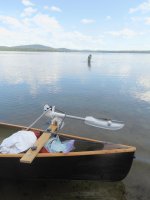G
Guest
Guest
Here’s the deal. I have a 20 foot long x 40 inch wide, 105lb freighter canoe. I don’t paddle tandem anymore, even in lightweight, nimble canoes, so that beastly burden has not been on the water in years. And that just isn’t right.
A friend has a use for it in hauling out the tools and materials needed to do site maintenance, and a motor would be beyond helpful, all the more so because he has 1.5 million acres of sites to choose from (Everglades).
A square stern Grumman 19 footer would be ideal, especially for oyster bar scrapage, but those are unicorns on Craigslist.
That heavy and big arsed double ender tripper should easily accommodate a small gas engine, probably something like a 3 to 5 HP range and carry a half ton of tools, gas and gear, especially with a solo motorman.
Does anyone remember what HP the Tripper XL was rated for enginewise?
FWIW, here’s a freaking 16’ Camper with a 2.5 HP motor.
https://www.youtube.com/watch?v=PWC_pNODzY4
Oh heck yeah. I might even reconsider my distaste for motors. That dislike is based largely on a failed history of maintaining small engines, but if it was someone else’s motorman problem I believe I could easily acclimate to sitting in the bow and watching the world go by.
Most of the DIY motor mounts I have seen are for electric motors. Does anyone use a small gas-motor mount in a freighter canoe? Got a DIY design, or other recommendations?
A friend has a use for it in hauling out the tools and materials needed to do site maintenance, and a motor would be beyond helpful, all the more so because he has 1.5 million acres of sites to choose from (Everglades).
A square stern Grumman 19 footer would be ideal, especially for oyster bar scrapage, but those are unicorns on Craigslist.
That heavy and big arsed double ender tripper should easily accommodate a small gas engine, probably something like a 3 to 5 HP range and carry a half ton of tools, gas and gear, especially with a solo motorman.
Does anyone remember what HP the Tripper XL was rated for enginewise?
FWIW, here’s a freaking 16’ Camper with a 2.5 HP motor.
https://www.youtube.com/watch?v=PWC_pNODzY4
Oh heck yeah. I might even reconsider my distaste for motors. That dislike is based largely on a failed history of maintaining small engines, but if it was someone else’s motorman problem I believe I could easily acclimate to sitting in the bow and watching the world go by.
Most of the DIY motor mounts I have seen are for electric motors. Does anyone use a small gas-motor mount in a freighter canoe? Got a DIY design, or other recommendations?

